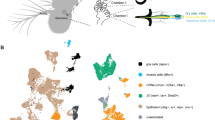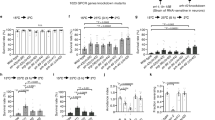Abstract
The ability to detect variations in humidity is critical for many animals. Birds, reptiles and insects all show preferences for specific humidities that influence their mating, reproduction and geographic distribution1,2. Because of their large surface area to volume ratio, insects are particularly sensitive to humidity, and its detection can influence their survival3,4,5,6,7. Two types of hygroreceptors exist in insects: one responds to an increase (moist receptor) and the other to a reduction (dry receptor) in humidity4,6,8. Although previous data indicated that mechanosensation might contribute to hygrosensation6,9, the cellular basis of hygrosensation and the genes involved in detecting humidity remain unknown. To understand better the molecular bases of humidity sensing, we investigated several genes encoding channels associated with mechanosensation, thermosensing or water transport. Here we identify two Drosophila melanogaster transient receptor potential channels needed for sensing humidity: CG31284, named by us water witch (wtrw), which is required to detect moist air, and nanchung (nan), which is involved in detecting dry air. Neurons associated with specialized sensory hairs in the third segment of the antenna express these channels, and neurons expressing wtrw and nan project to central nervous system regions associated with mechanosensation. Construction of the hygrosensing system with opposing receptors may allow an organism to very sensitively detect changes in environmental humidity.
This is a preview of subscription content, access via your institution
Access options
Subscribe to this journal
Receive 51 print issues and online access
$199.00 per year
only $3.90 per issue
Buy this article
- Purchase on Springer Link
- Instant access to full article PDF
Prices may be subject to local taxes which are calculated during checkout




Similar content being viewed by others
References
Sayeed, O. & Benzer, S. Behavioral genetics of thermosensation and hygrosensation in Drosophila . Proc. Natl Acad. Sci. USA 93, 6079–6084 (1996)
Shelford, V. E. A comparison of the responses of animals in gradient of environmental factors with particular reference to the method of reaction of representatives of the various groups from protozoa to mammals. Science 48, 225–230 (1918)
Altner, H., Sass, H. & Altner, I. Relationship between structure and function of antennal chemo-, hygro-, and thermoreceptive sensilla in Periplaneta americana . Cell Tissue Res. 176, 389–405 (1977)
Tichy, H. Hygro- and thermoreceptive triad in antennal sensillum of the stick insect, Carausius morosus . J. Comp. Physiol. 132, 149–152 (1979)
Yokohari, F. The coelocapitular sensillum, an antennal hygro- and thermoreceptive sensillum of the honey bee, Apis mellifera L. Cell Tissue Res. 233, 355–365 (1983)
Itoh, T., Yokohari, F. & Tominaga, Y. Two types of antennal hygro- and thermoreceptive sensilla of the cricket, Gryllus bimaculatus (De Geer). Zoolog. Sci. 1, 533–543 (1984)
Iwasaki, M., Itoh, T., Yokohari, F. & Tominaga, Y. Identification of antennal hygroreceptive sensillum and other sensilla of the firefly, Luciola cruciata . Zoolog. Sci. 12, 725–732 (1995)
Yokohari, F. & Tateda, H. Moist and dry hygroreceptors for relative humidity of the cockroach, Periplaneta americana L. J. Comp. Physiol. 106, 137–152 (1976)
Yokohari, F. Hygroreceptor mechanism in the antenna of the cockroach Periplaneta . J. Comp. Physiol. 124, 53–60 (1978)
Welsh, M. J., Price, M. P. & Xie, J. Biochemical basis of touch perception: mechanosensory function of degenerin/epithelial Na+ channels. J. Biol. Chem. 277, 2369–2372 (2002)
Clapham, D. E. TRP channels as cellular sensors. Nature 426, 517–524 (2003)
Littleton, J. T. & Ganetzky, B. Ion channels and synaptic organization: analysis of the Drosophila genome. Neuron 26, 35–43 (2000)
Montell, C. Drosophila TRP channels. Pflugers Arch. 451, 19–28 (2005)
Desbordes, S. C., Chandraratna, D. & Sanson, B. A screen for genes regulating the wingless gradient in Drosophila embryos. Genetics 170, 749–766 (2005)
Kim, J. et al. A TRPV family ion channel required for hearing in Drosophila . Nature 424, 81–84 (2003)
Yao, C. A., Ignell, R. & Carlson, J. R. Chemosensory coding by neurons in the coeloconic sensilla of the Drosophila antenna. J. Neurosci. 25, 8359–8367 (2005)
Sweeney, S. T., Broadie, K., Keane, J., Niemann, H. & O'Kane, C. J. Targeted expression of tetanus toxin light chain in Drosophila specifically eliminates synaptic transmission and causes behavioral defects. Neuron 14, 341–351 (1995)
Shanbhag, S. R., Muller, B. & Steinbrecht, R. A. Atlas of olfactory organs of Drosophila melanogaster. 1. Types, external organization, innervation and distribution of olfactory sensilla. Int. J. Insect Morphol. Embryol. 28, 377–397 (1999)
Stocker, R. F. Drosophila as a focus in olfactory research: mapping of olfactory sensilla by fine structure, odor specificity, odorant receptor expression, and central connectivity. Microsc. Res. Tech. 55, 284–296 (2001)
de Bruyne, M., Foster, K. & Carlson, J. R. Odor coding in the Drosophila antenna. Neuron 30, 537–552 (2001)
Gong, Z. et al. Two interdependent TRPV channel subunits, inactive and Nanchung, mediate hearing in Drosophila . J. Neurosci. 24, 9059–9066 (2004)
Homberg, U., Christensen, T. A. & Hildebrand, J. G. Structure and function of the deutocerebrum in insects. Annu. Rev. Entomol. 34, 477–501 (1989)
Walker, R. G., Willingham, A. T. & Zuker, C. S. A Drosophila mechanosensory transduction channel. Science 287, 2229–2234 (2000)
Nishikawa, M., Yokohari, F. & Ishibashi, T. Central projections of the antennal cold receptor neurons and hygroreceptor neurons of the cockroach Periplaneta americana . J. Comp. Neurol. 361, 165–176 (1995)
Keil, T. A. Functional morphology of insect mechanoreceptors. Microsc. Res. Tech. 39, 506–531 (1997)
Liu, L., Yermolaieva, O., Johnson, W. A., Abboud, F. M. & Welsh, M. J. Identification and function of thermosensory neurons in Drosophila larvae. Nature Neurosci. 6, 267–273 (2003)
Dhaka, A., Viswanath, V. & Patapoutian, A. Trp ion channels and temperature sensation. Annu. Rev. Neurosci. 29, 135–161 (2006)
Niemeyer, B. A. Structure–function analysis of TRPV channels. Naunyn Schmiedebergs Arch. Pharmacol. 371, 285–294 (2005)
Rein, K., Zockler, M. & Heisenberg, M. A quantitative three-dimensional model of the Drosophila optic lobes. Curr. Biol. 9, 93–96 (1999)
Wolff, T. in Drosophila Protocols (eds Sullivan, W., Ashburner, M. & Hawley, R. S.) 229–234 (Cold Spring Harbor Laboratory, Cold Spring Harbor, New York, 2000)
Acknowledgements
We thank T. O. Moninger for help with scanning electron microscopy, Y. Ben-Shahar for discussions, and K. Knudtson and the University of Iowa DNA Core Facility for assistance with sequencing, oligonucleotide synthesis and real-time PCR experiments. Supported in part by an NRL grant (C.K.). M.J.W. is an Investigator of the HHMI.
Author Contributions L.L. was responsible for molecular cloning, behavioural tests, extracellular electrophysiology, statistical analysis and preparation of the manuscript. Y.L. performed molecular cloning, transgenic generation, fly genetics and in situ hybridization. R.W. and Q.D. did in vitro wtrw cDNA expression and electrophysiology (data not shown in manuscript). C.Y. and H.H. were responsible for immunohistochemistry of wtrw and nan promoter expression in the brain. C.K. provided nan mutant, promoter and rescue flies. M.J.W. supervised the work and wrote the manuscript.
Author information
Authors and Affiliations
Corresponding author
Ethics declarations
Competing interests
The authors declare no competing financial interests.
Supplementary information
Supplementary Information
The file contains Supplementary Footnotes with additional references and Supplementary Figures S1-S9 with Legends. (PDF 5338 kb)
Rights and permissions
About this article
Cite this article
Liu, L., Li, Y., Wang, R. et al. Drosophila hygrosensation requires the TRP channels water witch and nanchung. Nature 450, 294–298 (2007). https://doi.org/10.1038/nature06223
Received:
Accepted:
Issue Date:
DOI: https://doi.org/10.1038/nature06223
This article is cited by
-
The pharyngeal taste organ of a blood-feeding insect functions in food recognition
BMC Biology (2024)
-
Pentylamine inhibits humidity detection in insect vectors of human and plant borne pathogens
Scientific Reports (2022)
-
Humidity response in Drosophila olfactory sensory neurons requires the mechanosensitive channel TMEM63
Nature Communications (2022)
-
Dopamine modulation of sensory processing and adaptive behavior in flies
Cell and Tissue Research (2021)
-
Identification, characterization and expression analysis of transient receptor potential channel genes in the oriental fruit fly, Bactrocera dorsalis
BMC Genomics (2018)
Comments
By submitting a comment you agree to abide by our Terms and Community Guidelines. If you find something abusive or that does not comply with our terms or guidelines please flag it as inappropriate.



